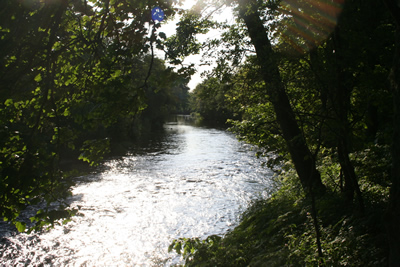Yesterday in lowish water Moray had an 11 lbs salmon from Frank’s Stream, which is his favourite FCW pool. The fish took a size 10 Finavon Cascade variant tied by Pete at the point where the current, after deflecting away from the S bank, spreads out across the river. Whilst not detracting from Moray’s lovely fish, Frank’s Stream must be the easiest FCW pool to fish: indeed you could fish it in your carpet slippers, barely getting the uppers wet, so well trimmed is the grass along its bank!
Today the river is running at 4″ with a healthy ‘bulge’ around the sides of the Armchair (webcam) boulder. The water is clear and the colour of a very pale malt whisky. Conditions are perfect for dawn and dusk fishing. And there are fish in the pools!
Freshwater Mussels in the South Esk
There is concern in SNH and the Esk Trust about the wellbeing of South Esk Freshwater Mussels (Margaritifera margaritifera). The well-known mussel beds at the Sawmill Dam on Cortachy Castle water, where regeneration of the mollusc has been monitored over a number of years, are showing a decline. Noone knows why, although the ERFT view is that it may be because of excessive amounts of silt being washed down from Glen Clova. The SNH/SEPA view is that there may be an issue with pesticides, but their origin and precisely how they affect the mussel is unknown. Further down the river, as I mentioned in a previous blog, large numbers of mussel shells, of varying sizes, indicating a range of age groups, were washed out by the winter spates. Marshall Halliday, the Trust’s director, feels that the increasingly violent spate ‘events’, that did not occur in the past, may be causing damage to mussel beds. I think there may also be a connection with the loss of the dams on the river (only Kinnaird remains as an effective barrier and ‘holder back’ of a significant reservoir of water) because the quieter water and lades associated with these structures provided habitat for freshwater mussels. Disappearance of the dams (or ‘dykes’) has removed those ‘oases’ of suitable habitat.
You may be wondering why freshwater mussels are important, and indeed why I keep on banging on about them. My angle on the subject is based on awareness of the important SAC (Special Area of Conservation) status of the South Esk. This EU designation has provided the River with its priority status for habitat enhancement, and with that some really significant amounts of money. Margaritifera margaritifera is not just an interesting freshwater species, which it certainly is: it is also a biological indicator that tells us a lot about the condition of the River – its habitat, flows and water quality. Most of all, because of a fascinating parasitic relationship with the salmon (and sea trout) it tells us a lot about where our salmon and sea trout are going within the catchment, and has undoubted indicator implications for the health of individual populations of both species of fish. And all this because the larvae (Glochidium) of the mussel hitch a ride in the gills of our wild salmon and sea trout! How else could they get upriver you might ask?
* If you are interested in finding out more about the freshwater mussel I recommend Fred Woodward’s superb little book ‘The Scottish Pearl in its World Context” Diehard 1994 ISBN 0-946230-27-7 or, on the law, the Scottish Executive pamphlet “Scottish Conservation Priorities” – freshwater pearl mussels, pressures, conservation and enforcement of wildlife law.
Here’s a photo of Tyndals taken early this morning. The river rose a few inches overnight, but by 0900 was dropping back slowly.
TA
